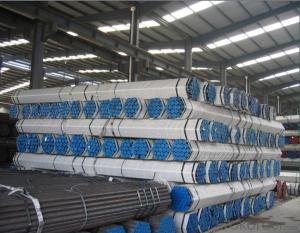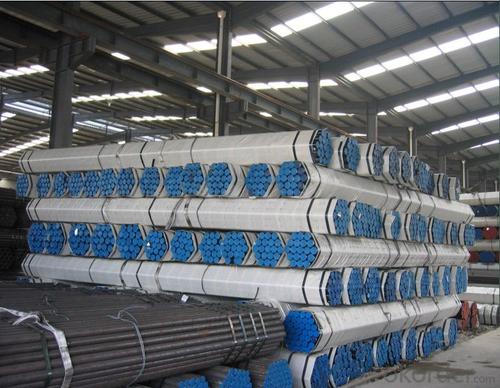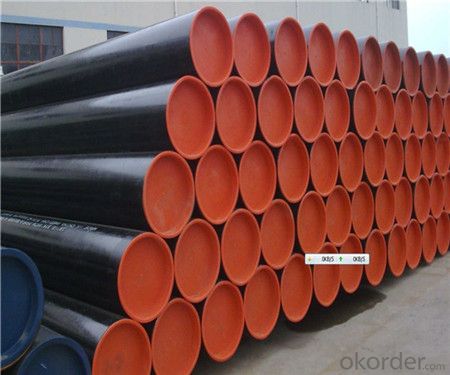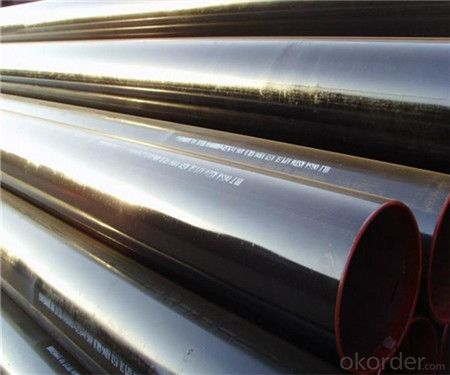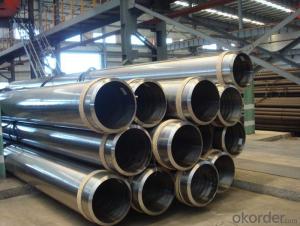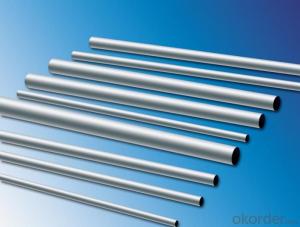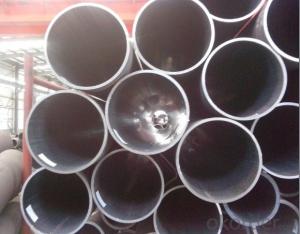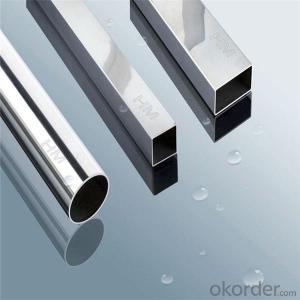Seamless Pipe for Pressure Purpose(EN 10216-1)
- Loading Port:
- China Main Port
- Payment Terms:
- TT or LC
- Min Order Qty:
- 30 m.t.
- Supply Capability:
- 12000 m.t./month
OKorder Service Pledge
OKorder Financial Service
You Might Also Like
`1、Seamless pipe for pressure purpose
Standard Specification: EN 10216-1
●Steel grades, Chemical composition and Mechanical properties
Note: a: Quality TR1 Delivery condition: as formed or normalized or normalizing-formed
b: Quality TR2 Delivery condition: as normalized or normalizing-formed
2、Main Features of the Seamless Pipe EN 10216-1:
1) Material:20#(ASTM A 106/A53 GRB.API5LGRB,GB),45#,16Mn,10#.
2) Specification range:OD:21.3-610mm,WT:6-70mm,length:6-12m or according to the requirement of clients.
3) Excutive standards:GB,ASME API5L.ASTM A 106/A53,Despite of the above standards,we can also supply seamless steel pipe with standard of DIN,JIS,and so on,and also develop new products according to the requirements of our clients!
4) Surface:black lacquered,varnish coating or galvanized.
5) Ends:Beveled or square cut,plastic capped,painted.
6) Packing:bundles wrapped with strong steel strip,seaworthy packing.
3、Seamless Pipe EN 10216-1Specification:
Standard | GB, DIN, ASTM ASTM A106-2006, ASTM A53-2007 |
Grade | 10#-45#, 16Mn 10#, 20#, 45#, 16Mn |
Thickness | 8 - 33 mm |
Section Shape | Round |
Outer Diameter | 133 - 219 mm |
Place of Origin | Shandong, China (Mainland) |
Secondary Or Not | Non-secondary |
Application | Hydraulic Pipe |
Technique | Cold Drawn |
Certification | API |
Surface Treatment | factory state or painted black |
Special Pipe | API Pipe |
Alloy Or Not | Non-alloy |
Length | 5-12M |
Outer Diameter | 21.3-610mm |
Grade | 20#, 45#, Q345, API J55, API K55, API L80, API N80, API P110, A53B |
Standard | ASME, ASTM |
4、Packaging & Delivery
Packaging Details: | seaworthy package,bundles wrapped with strong steel strip |
Delivery Detail: | 15-30days after received 30%TT |
5、FAQ of Seamless Pipe EN 10216-1:
①How is the quality of your products?
Our products are manufactured strictly according to national and internaional standard, and we take a test
on every pipe before delivered out. If you want see our quality certifications and all kinds of testing report, please just ask us for it.
Guaranteed: If products’ quality don’t accord to discription as we give or the promise before you place order, we promise 100% refund.
②How about price?
Yes, we are factory and be able to give you lowest price below market one, and we have a policy that “ for saving time and absolutely honest business attitude, we quote as lowest as possible for any customer, and discount can be given according to quantity”,if you like bargain and factory price is not low enough as you think, just don’t waste your time.Please trust the quotation we would give you, it is professional one.
③Why should you chose us?
Chose happens because of quality, then price, We can give you both.Additionally, we can also offer professional products inquiry, products knowledge train(for agents), smooth goods delivery, exellent customer solution proposals.Our service formula: good quality+good price+good service=customer’s trust
SGS test is available, customer inspection before shipping is welcome, third party inspection is no problem.
6、Seamless Pipe EN 10216-1 Images:
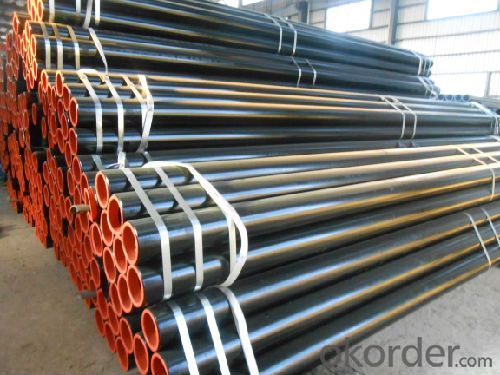
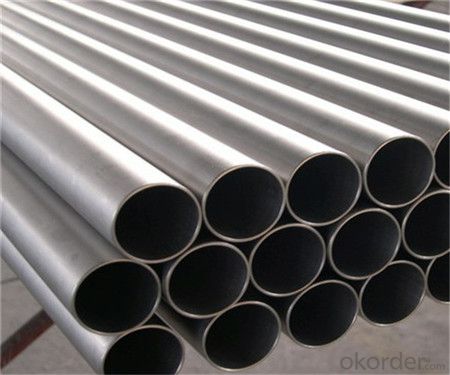

- Q: Can steel pipes be used for water wells?
- Yes, steel pipes can be used for water wells. Steel pipes are commonly used for constructing water wells due to their durability, strength, and resistance to corrosion. They can withstand high water pressure and provide a reliable and long-lasting solution for accessing underground water sources.
- Q: What is the standard length of steel pipes?
- The standard length of steel pipes varies depending on the industry and application. However, common standard lengths for steel pipes range from 18 to 22 feet, with some variations based on specific requirements or international standards.
- Q: What is the thermal conductivity of steel pipes?
- The thermal conductivity of steel pipes can vary depending on the specific type of steel used and its composition. However, on average, the thermal conductivity of steel pipes is around 50-60 watts per meter-kelvin (W/mK). This means that steel pipes are relatively good conductors of heat, allowing for efficient transfer of thermal energy. The high thermal conductivity of steel pipes makes them suitable for various applications, including heating systems, industrial processes, and infrastructure projects where heat transfer is essential.
- Q: What are the environmental impacts of steel pipe production?
- The environmental impacts of steel pipe production include the extraction and processing of raw materials, such as iron ore and coal, which contribute to deforestation, habitat destruction, and air and water pollution. The manufacturing process also emits greenhouse gases and other pollutants, contributing to climate change and air pollution. Additionally, the disposal of waste materials and the potential for leaks or spills during transportation can harm ecosystems and water sources.
- Q: Can steel pipes be used in extreme weather conditions?
- Yes, steel pipes can be used in extreme weather conditions. Steel is known for its high strength and durability, making it suitable for a wide range of applications including construction, infrastructure, and transportation. Steel pipes are commonly used to transport fluids and gases in various industries, and they are designed to withstand harsh environmental conditions, including extreme temperatures, high pressures, and corrosive environments. In extreme weather conditions such as extreme heat, cold, or heavy rain, steel pipes can maintain their structural integrity and functionality. Additionally, steel pipes can be coated or insulated to provide additional protection against corrosion and to maintain desired temperatures. Overall, steel pipes are a reliable choice for use in extreme weather conditions due to their strength, durability, and resistance to various environmental factors.
- Q: What are the different methods of inspecting steel pipes?
- There are several methods of inspecting steel pipes, including visual inspection, non-destructive testing (such as ultrasonic testing, magnetic particle testing, and dye penetrant testing), radiographic testing, and eddy current testing. These methods help identify any defects, such as cracks, corrosion, or wall thickness variations, ensuring the quality and integrity of the steel pipes.
- Q: How are steel pipes sized and classified?
- The primary criteria for sizing and categorizing steel pipes are their outer diameter (OD) and wall thickness. This standardization ensures compatibility and ease of use across different applications. The common approach to sizing steel pipes is through nominal pipe size (NPS), a North American standard that refers to a pipe's OD. NPS sizes span from 1/8 inch to 36 inches, with each size corresponding to a specific OD. For instance, a 1/2-inch NPS pipe has an OD of 0.84 inches, while a 12-inch NPS pipe has an OD of 12.75 inches. It's important to note that the pipe's OD may not precisely match its actual measurement due to historical dimensions. Moreover, steel pipes are categorized into various schedules, which indicate the wall thickness. The most common schedules are SCH 5, SCH 10, SCH 40, SCH 80, and SCH 160, with higher numbers representing thicker walls. These schedules are standardized and aid in selecting the appropriate pipe for specific applications. Additionally, steel pipes can be further classified based on their end connections. The typical types include threaded, plain-end, and socket-weld connections. Threaded pipes possess screw threads on both ends, facilitating easy assembly and disassembly. Plain-end pipes lack threads and are typically joined using welding techniques. Socket-weld pipes have a socket-like end that enables welding with a corresponding fitting. In conclusion, steel pipes undergo sizing and classification based on their outer diameter, wall thickness, and end connections. The nominal pipe size (NPS) denotes the outer diameter, while the schedule number represents the wall thickness. Understanding the sizing and classification of steel pipes is crucial when selecting the appropriate pipe for specific applications in industries like construction, oil and gas, plumbing, and manufacturing.
- Q: What is the maximum allowable pressure for steel pipes?
- Various factors, such as the type of steel used, the pipe's diameter and thickness, and specific industry requirements, determine the maximum pressure allowed for steel pipes. The American Society of Mechanical Engineers (ASME) offers guidelines and standards for pressure vessel and piping design, which include determining the maximum allowable pressure. For power piping and process piping, ASME B31.1 and B31.3 are commonly used codes, respectively. These codes establish design criteria for different materials, including steel, and provide formulas and charts to calculate the maximum allowable pressure for different pipe sizes and wall thicknesses. The maximum allowable pressure is typically determined based on the pipe's ability to withstand internal pressure without experiencing permanent deformation or failure. It is important to consider other factors, such as temperature, corrosion, and the presence of external loads or stresses, as they may also impact the maximum allowable pressure for steel pipes. Therefore, it is essential to refer to the relevant codes, standards, and engineering calculations specific to the application to ensure the safe and reliable operation of steel pipes under the given conditions.
- Q: What are the environmental impacts of using steel pipes?
- The environmental impacts of using steel pipes include the extraction and processing of raw materials, energy consumption during manufacturing, and carbon emissions. Additionally, the disposal of steel pipes can contribute to landfill waste. However, steel pipes are highly durable, recyclable, and have a long lifespan, which mitigates some of these negative impacts.
- Q: Are steel pipes suitable for food processing facilities?
- Yes, steel pipes are suitable for food processing facilities. Steel pipes are widely used in the food processing industry due to their numerous benefits. Firstly, steel pipes are highly durable and can withstand high temperatures, pressures, and corrosive substances often used in food processing. This ensures the pipes will not degrade or contaminate the food products. Additionally, steel pipes are easy to clean and maintain, making them ideal for maintaining high levels of hygiene required in food processing facilities. Steel pipes also have excellent resistance to bacteria growth, further ensuring the safety and quality of the food being processed. Furthermore, steel pipes are cost-effective and have a long lifespan, making them a reliable and economical choice for food processing facilities. Overall, steel pipes are a suitable and preferred option for food processing facilities due to their durability, cleanliness, and resistance to contamination.
Send your message to us
Seamless Pipe for Pressure Purpose(EN 10216-1)
- Loading Port:
- China Main Port
- Payment Terms:
- TT or LC
- Min Order Qty:
- 30 m.t.
- Supply Capability:
- 12000 m.t./month
OKorder Service Pledge
OKorder Financial Service
Similar products
Hot products
Hot Searches
Related keywords
